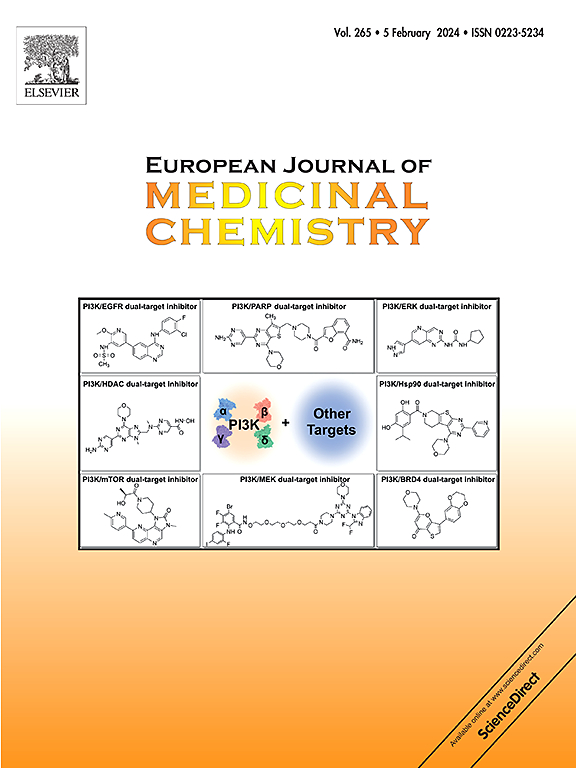Discovery of a first-in-class protein arginine methyltransferase 1 (PRMT1) degrader for nonenzymatic functions studies
IF 6
2区 医学
Q1 CHEMISTRY, MEDICINAL
引用次数: 0
Abstract
Among the type I Protein Arginine Methyltransferases (PRMTs), PRMT1 plays a predominant part in catalyzing asymmetric dimethylation of arginine residues on histone or nonhistone substrates. PRMT1 level is abnormally elevated in numerous cancer cell types and inflammation diseases. Compared to the enzymatic functions of PRMT1, its nonenzymatic functions are shortly investigated in diseases. Previous study has confirmed that the stability of orphan receptor TR3, a binding partner of PRMT1, is closely regulated by PRMT1, but the effect is independent of PRMT1's methyltransferase activity, but depends on the physical binding of PRMT1. To date, multiple inhibitors targeting methyltransferase enzymatic activity of PRMT1 are developed, but all of them lack selectivity for PRMT1. Among them, only GSK3368715 advanced to clinical trials but was discontinued in phase I due to inadequate efficacy and thrombosis toxicity. Currently, small molecule degraders are gaining significant attention due to their advantages in efficacy and selectivity in therapeutic applications. Presumably, a potent and selective PRMT1 degrader could serve as a valuable alternative in the treatment of PRMT1-driven diseases and act as an instrumental tool in uncovering additional nonenzymatic functions of PRMT1. To date, however, the development of a PRMT1 degrader remains a challenge, with no such agents reported. In this study, we present the design, synthesis and characterization of CM112 (compound 12), a first-in-class PRMT1 degrader, designed by tethering adamantane to MS023, a type I PRMTs pan inhibitor, via a 5-PEG linker. CM112 demonstrates a concentration- and time-dependent ability to induce PRMT1 degradation in various solid cancer cell lines. Additionally, CM112 shows high selectivity for PRMT1 degradation, without causing degradation of other type I PRMTs (PRMT3/4/6), although it retains potent inhibitory effects on their enzymatic activity. Pharmacokinetics studies indicated that CM112 possesses favorable bioavailability in mice. Notably, as anticipated, CM112 could target PRMT1's nonenzymatic function by downregulating the stability of the orphan receptor TR3, an effect not observed with the PRMT1 inhibitor MS023, that is in consistence with the previous findings. Taken together, CM112 represents a valuable tool for elucidating the unknown, methyltransferase-independent roles of PRMT1 in disease progression and pave the way for developing more potent and drug like PRMT1 degraders in future.


发现用于非酶功能研究的一流蛋白质精氨酸甲基转移酶 1 (PRMT1) 降解剂
在I型蛋白精氨酸甲基转移酶(PRMTs)中,PRMT1在催化组蛋白或非组蛋白底物上精氨酸残基的不对称二甲基化中起主要作用。PRMT1水平在许多癌症细胞类型和炎症疾病中异常升高。与PRMT1的酶功能相比,其在疾病中的非酶功能研究较少。既往研究证实,孤儿受体TR3作为PRMT1的结合伙伴,其稳定性受到PRMT1的密切调控,但其作用不依赖于PRMT1的甲基转移酶活性,而是依赖于PRMT1的物理结合。迄今为止,已经开发出多种靶向PRMT1甲基转移酶活性的抑制剂,但它们都对PRMT1缺乏选择性。其中只有GSK3368715进入临床试验,但由于疗效不足和血栓毒性而在I期停药。目前,小分子降解剂因其在治疗应用中的有效性和选择性等优势而备受关注。据推测,一种有效的、选择性的PRMT1降解剂可以作为治疗PRMT1驱动疾病的一种有价值的替代方案,并作为揭示PRMT1其他非酶功能的工具。然而,到目前为止,PRMT1降解剂的开发仍然是一个挑战,没有这样的药物报道。在这项研究中,我们设计,合成和表征了CM112(化合物12),这是一种一流的PRMT1降解剂,通过5-PEG连接剂将金刚烷系在I型PRMT1 pan抑制剂MS023上。CM112在多种实体癌细胞系中显示出浓度和时间依赖性诱导PRMT1降解的能力。此外,CM112对PRMT1的降解表现出高选择性,而不会导致其他I型prmt (PRMT3/4/6)的降解,尽管它对它们的酶活性保持有效的抑制作用。药代动力学研究表明,CM112在小鼠体内具有良好的生物利用度。值得注意的是,正如预期的那样,CM112可以通过下调孤儿受体TR3的稳定性来靶向PRMT1的非酶功能,而PRMT1抑制剂MS023没有观察到这种作用,这与先前的研究结果一致。综上所述,CM112为阐明PRMT1在疾病进展中未知的、不依赖甲基转移酶的作用提供了有价值的工具,并为未来开发更有效的、类似于药物的PRMT1降解物铺平了道路。
本文章由计算机程序翻译,如有差异,请以英文原文为准。
求助全文
约1分钟内获得全文
求助全文
来源期刊
CiteScore
11.70
自引率
9.00%
发文量
863
审稿时长
29 days
期刊介绍:
The European Journal of Medicinal Chemistry is a global journal that publishes studies on all aspects of medicinal chemistry. It provides a medium for publication of original papers and also welcomes critical review papers.
A typical paper would report on the organic synthesis, characterization and pharmacological evaluation of compounds. Other topics of interest are drug design, QSAR, molecular modeling, drug-receptor interactions, molecular aspects of drug metabolism, prodrug synthesis and drug targeting. The journal expects manuscripts to present the rational for a study, provide insight into the design of compounds or understanding of mechanism, or clarify the targets.

 求助内容:
求助内容: 应助结果提醒方式:
应助结果提醒方式:


